One of the worst things about traveling alone is getting sick.
I’m typically a hale sort, and I’ve gotten sick only a few times on my solo travels.
The first was in Vietnam, a dozen years ago. Whether it was flu or food poisoning I never knew, but I canceled my onward flight and called my future husband. If I died, I wanted somebody to tell my mother where they’d buried my body.
The next time was in Las Vegas, and despite the party atmosphere, I can promise you this really was food poisoning. The drive to the Grand Canyon the next day wasn't much fun, but at least my stomach settled before I had saddled up for the all-day mule ride.
Today’s bout I’m blaming on TMB – too much barbecue – and TMD – too much driving. At times like this, you've just got to crash, and I spent a goodly bit of today in bed. Thankfully, it was in a cozy B&B, Cottage House, in the friendly town of Council Grove, Kansas, once a stop on the Santa Fe Trail. I can’t think of a better place to hole up for a day.
I did make it out to the Tallgrass Prairie Preserve, but that story will need to wait for a day or two. It’s back to bed for me. Meanwhile, here are a few photos:



Thursday, August 31, 2006
On the Prairie
Posted by
DARCOS CRUZ
at
7:27 PM
1 comments
![]()
![]()
Wednesday, August 30, 2006
Fab new video
Our tech wizard, Stephanie, has posted new video from the trip on our tracking page. Just click the icon at the top of the column to the right (Where's Jane Today?) Then click on the bottom right link where it says, Photos & Video.
Posted by
DARCOS CRUZ
at
9:27 PM
5
comments
![]()
![]()
Road hazard

I keep telling myself it had to happen sometime. It just didn’t have to hurt so badly.
Yes, I got a speeding ticket. About 10 miles east of Council Grove, Kansas.
The locals all nodded their heads. Oh yes, that place where the speed limit drops from 65 to 55. A known speed trap.
I am not telling how fast I was going or how painful the ticket was. Let’s just say that that cashmere sweater I bought at Neiman-Marcus right before I left on this trip will have to be returned. I've still got the receipt.
---------
Photo: Sculpture in a field near the site of the ticket.
Posted by
DARCOS CRUZ
at
9:21 PM
2
comments
![]()
![]()
Artful city
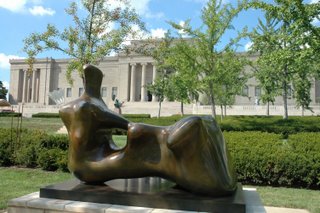
You didn’t vote for it, but I still stopped by the Nelson-Atkins Art Museum for a preview of its newly refurbished sculpture garden opening Sept. 30.
I’d been to the museum the day before for lunch, and it proved on the tastiest meals of my trip. Clean fresh salads, lusty soups, sandwiches on homemade bread with crunchy ingredients. It’s an example Miami’s museums need to copy.
The Nelson-Atkins boasts an extraordinary wide-ranging collection from American masters to African, Egyptian and Asian Art, and it’s contemporary collection is growing. To house all this, the museum is adding a new wing that has been controversial, to say the least. It opens in June.
The old building is a spectacular example of neoclassical architecture, built in the 1930s when such craftsmanship was available. The new building is a sculptural glass-on-glass play on prairie architecture by Stephen Holl. Much of the new building lies underground. The idea, said Jan Schall, one of the curators, is to keep the new building from overshadowing the temple-like grandeur of the old.
The sculpture garden was originally opened in 1989; in 2002, the entrance side of it was reconfigured. With the addition of the new building, the Nelson-Atkins needed to reshape the grounds. It took the opportunity to change plantings and reposition some sculptures.
The sculpture group includes a Rodin Thinker, Claes Oldenburg and Coosje van Bruggen’s Shuttlecocks (you might remember Miami has their work, Dropped Bowl, downtown, though I hear it’s fallen into disrepair), a Calder, a George Segal and the largest collection of monumental Henry Moores outside London.
All this in Kansas City. 
Posted by
DARCOS CRUZ
at
9:09 PM
0
comments
![]()
![]()
Kansas City rising

I cheated, sort of.
You voted for the Phoenix Bar & Grill for jazz tonight. I got the vote results Tuesday night and went then, so I could move on down the road today.
The club is in a historic corner of downtown. Cozy little corner place with exposed brick walls, cheery bartender (Mark) who makes this killer vodka drink called a Strawberry Bomb Pom, a jazz-inspired menu (I couldn’t resist the Tito Puente Macho Nachos) and, on this night at least, really juicy tunes.
At the keyboard was Everette Devan, the Tuesday night regular, with his jam session, which involved two guitarists and rotating singers. The whole thing was like a really smooth Scotch: smoky and soulful and a little dangerous.
It was pretty dead when the music started at 7 p.m., though it picked up later. Downtown is torn up due to construction, and Main Street was further clogged by a bomb scare (false alarm.) Only one other early listener was in the place. We got to chatting; he’s a lawyer.
He filled me in, as people in bars do, on the local scene. The take from a self-professed political conservative:
-The new city manager who came two years ago from Denver is doing a great job in turning around downtown, but he’s black and that creates problems in a largely segregated city where a mixed population means Catholics plus others.
-Housing prices have gone up in the last decade but not as much as in coastal cities, and they've been flat for the past few years.
-Wichita is the new nexus of conservative political dollars.
-Everybody he knows is completely embarrassed by the Creationist school board in Kansas. He's from Kansas. (K.C. straddles Missouri and Kansas, and each side had plenty of jokes about the other.)
The impression I got from him and pretty much everybody else I spoke with is that Kansas City is a place heading a good direction.
A young guy came in and was actually smoking at the bar. Smoking! It’s still legal here. Seems everything isn’t quite up to date in Kansas City after all. 
Posted by
DARCOS CRUZ
at
8:51 PM
1 comments
![]()
![]()
Whew!
Report from the homefront is that Ernesto is soggy but otherwise not too bad. Whew!
Posted by
DARCOS CRUZ
at
5:51 AM
0
comments
![]()
![]()
Shopping with Mom

Ever since we met in night-school Spanish class more than 20 years ago, my best friend has been raving about the beauties of Kansas City, Mo. Not that she wants to live there. But she grew up about two hours away, outside the small town of Trenton, Mo., and she still goes to KC when she visits her mom.
Today, I finally understood what she’s talking about.
Her mom, Sue Gilhuly, and I met at The Plaza … properly Country Club Plaza … an Alhambra-esque outdoor shopping-and-entertainment zone built in 1922. It’s simply gorgeous.
And big surprise: Kate, my best friend, was with her mom.
This is a surprise because in cities from Miami to Honolulu, Kate and I have missed each other by a day, and if you hadn’t voted for me to come here today, we would have stayed on that track. I travel, Kate travels. She hangs out on Long Island. So visits are rare, and this was a treat.
Kate and her mom took great pleasure in showing me around. First stop was The Plaza, a village of exquisitely tiled towers and domes and storefronts. The idea is similar to Coral Gables, but The Plaza is far more ornate, and dotted with fountains for which it is justly famous.
Like most retail centers these days, it is filled with chain stores, but a few local icons remain. The best known of these is Hall’s, owned by the people who founded Hallmark Cards. It’s one of those rare department stores where every item has been hand-picked, and each is exquisite … and something you won’t see coming and going on the street.
Then, we took a spin around town, to the remarkable Beaux Arts Union Station, built in 1914 to handle the enormous trade of the area owing to its proximity to the Kansas and Missouri Rivers and cattle country. We rode along Ward Parkway through a neighborhood of mansions worthy of Newport, and through backstreets of homes on neatly tended lawns. More fountains, more parks, more green. 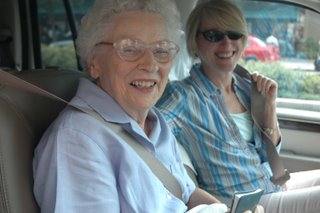
Kate and mom headed to the airport for Kate’s flight east, and I went back to The Plaza to investigate. Though I was dressed like a backpacker, clerks even in the toniest stores were delightful and welcoming, and I had a good laugh with the ladies in St. John, where of course I fell madly in love with a leather dress that is NOT in the budget. (No, I didn’t.)
The ladies in the Visitor Center were equally warm, which is what you’d expect but don’t always find. I’d booked a motel blind, and when I asked them about the area of town it’s in, the horrified looks on their faces said it all. I upgraded.
So here’s to Kansas City, friendly and beautiful and sophisiticated. Not that I’m ready to move here, mind you. Hurricanes and all, I’ll take Miami.
Posted by
DARCOS CRUZ
at
5:28 AM
3
comments
![]()
![]()
Monday, August 28, 2006
Navigation
A couple of you have asked about navigation. I'm using a combo method which works fairly well.
At night, when I find out where I'm going, I check AAA and Rand McNally websites for general directions.
In the car, I have a Rand McNally Atlas PLUS two GPS devices that I'm testing. One is by Garmin and one is by Rand McNally. I'm not supposed to release details on this for a bit, but let me say that both have some great features, and having a GPS has been invaluable in cities where I don't have great city maps. The GPS units sometimes take you in weird ways, and I've gotten lost twice, but I think that was operator error.
Posted by
DARCOS CRUZ
at
8:22 PM
3
comments
![]()
![]()
Getting kicks in Cuba
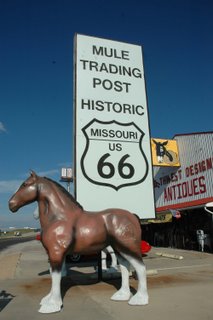
Famous though it may be, Route 66 is more a state of mind than a place. Finding it on the stretch from St. Louis to Springfield, Mo., took both a GPS and the Lonely Planet Route 66 Road Guide. And when I got to the Route 66 State Park, I bought yet another map with bigger type.
Once you get out of town, “The Main Street of America’’ is easier to find as it slips through pastures and forests, past state prisons and rusted-out auto body shops, around Wal-Mart Supercenters and the skeletons of once-beloved Mom-and-Pop motels that have now, literally, gone to the rats. In 1985, it was replaced by interstates, and often it parallels I-44.
Still, the roadway captures hearts. The volunteers at the Route 66 State Park near Eureka were busy selling fridge magnets and T-shirts and books on this Monday morning. The park is a biking-and-hiking center, but about 65 percent of the people who come in to the Visitors Center are looking for Route 66 info or memorabilia, one of the volunteers told me.
Many are foreigners beguiled by the spirit of the highway. While I was there perusing the exhibits, visitors included two girls from Spain, an Irish couple in a rented convertible, and a trio of young men who turned out to be Serbs.
I ran into the Serbs a few miles down the road, at a wayside souvenir stand in the shape of a trio of concrete teepees. The place looked appealing, and I’d been warned that they require you to pay a $2 fee. Turns out they require you to spend at least $2 on merchandise to even stand in their parking lot. None of us minded the $2 tariff, but the woman who owns the place was aggressive and downright rude, so personally, I’m boycotting.
We went inside, bought some rocks (cheapest things in the store) and then finally had a chance to chat. Turns out the guys are making a documentary about Route 66 for Serbian National Television. The talent is a handsome young man named Alex Marich; the roadtrip was his idea.
“I read a lot about Route 66. My favorite group is the Rolling Stones, and Route 66 is one of their songs. It’s great to travel coast to coast and meet people.’’
He and his two coworkers left Chicago five days ago and have 20 yet to go. Up to this point, he said, the best part of the trip had been the people he had talked with, all very friendly and hospitable. “It’s better than I expected because of the people,’’ – today’s experience being an exception. I apologized on behalf of the entire nation.
Marich and his crew had trouble keeping up with Route 66, and it’s no surprise. Often the Interstate eats it whole; at times the Historic Route 66 markers simply disappear, leaving you clueless. But I always made my way back on track.
A little background: Route 66 was officially created in 1926 at a meeting in Springfield, Mo. About the same time, the Phillips 66 gas company got started, getting its name from a company executive who drove to a pre-company launch meeting along Route 66. (The company originally employed six registered nurses to drive up and down the road to help any motorist in need, I learned at the State Park.)
The nurses and white-clad gasoline pump masters are long gone, but there’s enough of the charm and honky-tonk left to make for hard choices. I by-passed the Jesse James Wax Museum, Reptile Center and the Toy Museum in Stanton in favor of Meramec Caverns.
Having already visited Florida State Caverns on this trip, I was a bit caved out, but the attraction includes some true rarities – a 25-foot high stalagmite that is the world’s third largest, we were told – and a hokey-retro closing with Kate Smith singing America the Beautiful in front of a truly stunning curtain of formations. On top of that, the caves were used as a hideout by outlaw Jesse James and brother Frank, so who could resist?
Not the 150,000 people who come here annually, said owner Les Turilli. His grandparents started the attraction in 1933 with 12 paying guests. At one time the caverns were advertised in 30 states; today the billboards and painted barns all fall within a 300 mile radius, he said. Government won’t let him paint barns anymore, so when existing ones fall down, those advertisements are gone forever.
One of the highlights of this stretch of Route 66 was Cuba (pop: about 3,500). I stopped off at the newspaper, The Cuba Free Press. The owner and editor had gone, but two very nice ladies, Sandy Morice and Joy Brandenburger, gave me a flier explaining that Cuba was founded in 1857 “based on common sympathy for the island of Cuba, which was under the oppressive rule of Spain at the time.’’ In 2001, a community beautification group called itself Viva Cuba came up with a plan to commission a dozen murals depicting local history for the town walls; 11 are now complete. None show the other Cuba. 
Posted by
DARCOS CRUZ
at
8:10 PM
6
comments
![]()
![]()
Ernesto watch
Even from this distance, the hurricane watch -- paired with CNN's nonstop one-year-after stories about Katrina -- is unnerving. I'm thinking of everyone in Florida ... I know this isn't fun.
Posted by
DARCOS CRUZ
at
6:38 AM
2
comments
![]()
![]()
Gateway Arch

The Gateway Arch -- the centerpiece of the Jefferson National Expansion Memorial -- is a kind of underground theme park, and on this Sunday – just hours before the Cardinals / Cubs game – the place was packed.
Underground, you say? Though the steel arch rises 630 feet above ground, the facilities for it are all beneath it. It’s here that you come to see the Museum of Westward Expansion, a large format film on the Lewis & Clark expedition, a documentary on the building of the arch, two shops and a ticket center for the tram ride into the arch itself and a nearby riverboat ride.
Taking it all in can consume hours. A cheery young man named Charles (I promised I’d mention him) sold me a combo package of tickets that was really pretty reasonable: For $21 (I’m a National Parks annual pass holder), I got the one-hour river cruise, tram ride up the Arch, museum entry and the documentary film on the Arch’s creation. I saved $3.
The arch itself is a remarkable feat of both architecture and engineering. Land for a memorial marking the westward expansion was set aside in the 1930s, but it would be another 35 years before it was finished. In 1947, architect Eero Saarinen won the design competition for the memorial. Engineers and fabricators then went to work; the triangular steel sections for the arch were built in Pennsylvania, then shipped to St. Louis and installed over a two-year period. It was completed almost 41 years ago, in 1965. The documentary about its construction is well worth seeing, but even if you’re not afraid of heights, it will give you the willies. (No safety harnesses in sight!)
A cranky little tram ride in a five-place circular car – a kind of Ferris wheel in the dark – takes you to an observation deck at the crest of the Arch, and from here you can see the Old Courthouse where the Dred Scott case was heard (it’s actually park of this national park) and the stadium where the Cardinals were batting up.
The river cruise was less of a thrill. In Europe, where land is tight, cities are clustered around waterways, built high on their banks to guard against flooding. The Mississippi is a sad contrast, a brown and barren mess whose few surrounds are industrial and largely rusting. There’s little here to see, and less worth seeing. You’d think we could better. 
A terrorism note: In light of the recent thwarted airline attacks, the parks service isn’t allowing any liquids inside, and you have to drink or dump your water before entering. Bags are carefully checked by hand and then X-rayed; any “weapons’’ (such as my pepper spray) are left behind for retrieval when you leave.
----------
Photos: Top, the Gateway Arch in St. Louis; center, the tram car to the top; bottom, The Old Courthouse, seen from the top of the Gateway Arch. Photos by JANE WOOLDRIDGE/MIAMI HERALD.
Posted by
DARCOS CRUZ
at
6:28 AM
1 comments
![]()
![]()
Friendly Cape Girardeau

When Martha and Kenny Bender were teens, they remember, the muddy Mississippi often overwhelmed its banks and flooded into downtown Cape Girardeau, Mo. “People would be down here in canoes,’’ Kenny told me.
Since the 1960s, the town has been protected by a massive river wall … safe, but it wasn’t a pretty thing. So a few years ago the town decided to commission a series of murals depicting local history, including the visit of explorers Lewis and Clark in the early 1800s, and the beautified wall is now something of an attraction.
The Benders are the parents of Miami reader Becky Van Wagner. And though I don’t know Becky and her husband, teachers, she volunteered her parents to play tour guide should I make it to Cape Girardeau.
The town barely missed out to St. Louis’s Gateway Arch in our vote, and it was so nice of them all to offer that I stopped off anyway.
The Benders are retired now from business and mostly, from civic life, and they’re exactly the kind of warm, friendly people you’d like to have for aunt and uncle. Long active in this community of about 35,000, they’re proud of their town and delighted in showing it to a visitor.
We rode around and checked out the sights: Remarkable carvings of Ben Franklin, Abraham Lincoln and other figures by local carver A. W. Birk; beautiful homes from the 1920s; a church that was already open when Lewis and Clark came through; tile murals on the wall of the local newspaper, the Southeast Missourian; and graceful courthouse mentioned in Mark Twain’s Life on the Mississippi.
The local economics are driven by retail sales from area farmers, Southeast Missouri State University and two hospitals, I was told. This the largest town between Memphis and St. Louis.
We missed a couple of sights: the nearby park marking the Cherokee Trail of Tears, when thousands of Cherokees lost their lives in forced relocation, and an overlook of the town. A rainstorm and time were pushing in, and I headed on to St. Louis.
-------------
Photo: Kenny and Martha Bender, parents of Miami Herald reader Becky Van Wagner, in front of the river wall in Cape Girardeau, Mo. The scene behind them depicts the visit of explorers Lewis and Clark in the early 1800s. Photo by JANE WOOLDRIDGE/staff.
Posted by
DARCOS CRUZ
at
6:12 AM
3
comments
![]()
![]()
Saturday, August 26, 2006
Fellow road trippers

Beale Street is a slightly tacky strip of music clubs, souvenir shops and walk-up windows selling beer. Think New Orleans with a little less panache. But the music is irresistible, and walking down the street you can hear it all: Elvis hits from an impersonator, first-rate blues, Sweet Home Alabama, a little BB King, Jimmy Buffet from a karaoke duo.
It was in one of the souvenir shops – sorry, friends and family, I did buy Christmas presents here – that I ran into Lee and Magen Geiger of South Jersey, a father-daughter duo on the ultimate road trip.
In a week, the pair has gone down Virginia’s Skyline Drive, the Tail of the Dragon Road into N.C. and Tennessee, Sante Fe, Phoenix, Vegas, back to Memphis … with a few days left to go. Along the way they bought a six-week-old “Min Pin’’ – a precious miniature pinscher named Koko that was getting lots of oohs and aahs on the street.
“It’s the ultimate father-daughter bonding trip,’’ said Lee. And what have they learned along the way? “People in Tennessee can’t drive,’’ said Magen, 15. 
-------------
Photos: Top, Lee and Magen Geiger with Koko. Bottom, Beale Street.
Posted by
DARCOS CRUZ
at
9:02 PM
2
comments
![]()
![]()
Great ribs
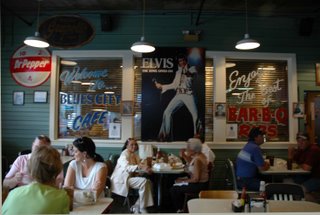
I rolled into downtown Memphis about 4:30. It was dead, and I figured this was a city I’d be happy to leave. Turned out that was wrong.
I checked into my downtown semi-budget hotel ($112) and headed out in search of Great Barbecue.
There’s been some debate here on the blog about just where to find the best barbecue in town. Rendevouz is the famous place, but it’s been bashed as “touristy.’’ One of you recommended Central BBQ, but I just couldn’t bring myself to get back in the car.
I asked the woman at the front desk, who confirmed a close-at-hand recommendation I’d gotten from another Tennessean: Blues City Café.
Turns out it’s a funky café on the corner of Beale Street. Pretentious it isn’t: we’re talking concrete floors, brick walls, vinyl booths and formica tables. “Put Some South in Your Mouth,’’ is its motto.
It’s a sad time for the place; chef Bonnie Mack recently died of a heart attack. But the feasting goes on, and what a feast it is!
I bypassed the catfish and tamales – both house specialties – a favor of the ribs. Good choice!
We’re talking wet rub ribs here, slow cooked at 225 degrees for about seven hours, then drenched in a sweet barbecue sauce with just a hint of tanginess (mustard?) underneath. The ribs were easily the most moist I’ve ever had, literally falling off the bone (no hope for getting them to your mouth intact.) The $13.95 half rack nearly killed me with too much food, but it was so yummy I couldn’t resist eating the whole thing.
My vote: Two sticky thumbs up.
Posted by
DARCOS CRUZ
at
8:58 PM
1 comments
![]()
![]()
Trip update
I'm a bit behind on tallies. Here are some numbers:
THURSDAY
245 miles
Expenses:
- Gas: $26.13
- Breakfast: $3.19
- Lunch: $8.68
- Dinner: $15
Total: $53
-----
FRIDAY
60 miles
Expenses:
- Lunch: $7.50
- Dinner: $30
Total: $37.50
------
SATURDAY
223 miles
Expenses:
- Gas: $24.93
- Lunch: $9.82
- Dinner: $19
- Sun Studio Tour: $9.50
- Graceland Tour: $30
- Parking: $6
- Hotel: $125
Total: $223.25
Posted by
DARCOS CRUZ
at
8:48 PM
1 comments
![]()
![]()
Elvis lives on
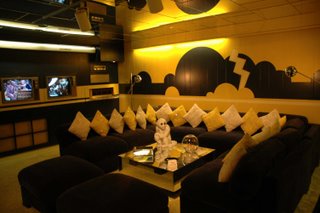
You can’t go to Memphis without visiting Graceland. At least, that’s what our voters said today.
So, where were you when you heard The King was dead? I was popping popcorn for minimum wage at a movie theater in Raleigh, N.C., where my step father, Sandy Jordan, manages a group of theaters. I don’t remember what feature was playing. But it was about half-way through the film when the phone in the box office started ringing off the wall with people trying to be the first to break the news to their spouses.
By then, he was Fat 1970’s Elvis, which wasn’t a great fashion moment for anybody, and certainly not for the side-burned King. But then, how could anybody so gorgeous and sweet-faced age well?
Graceland doesn’t dwell much on Elvis’s unflattering moments; this is, after all, a family-owned tribute for his fans. I can’t say I’m one of them, but it didn’t take long to be captivated by the unmatchable tenor of his voice and the magic of the innocence that stayed with him throughout his fame.
He was, as the museum reminds us, only 42 when he died.
You know the story: Poor family from Tupelo, first in his family to graduate from high school, singer turned superstar turned soldier, so dedicated to his parents that he brought them to Graceland to live with him. The handsome, polite, sloe-eyed, honey-voiced Elvis the Pelvis.
He bought Graceland and its 14 acres when he was 22 for $100,000. He died in the master suite bathroom of a heart attack brought on by use of prescription drugs on Aug. 16, 1977. The second floor where he died is closed to visitors.
Graceland turns out to be a comfortable South Colonial house, but not grand. It’s also not tacky … just a time-warp of fashion in the 1970s. Here is the purple bedroom for his parents, the 15-foot-long white sofa in the living room, the kitchen that always had food aplenty for friends and family. The TV room in the basement, with it’s three screens, and the Jungle Room, with this whimsical carved furniture and green snag carpeting on floors and ceiling.
Many spaces – including a one-time car racing track and another bi-level racquetball court – hold memorabilia, furniture and exhibits: a white fur Barbarella-style bed, a recreation of his office (books included Herman Hesse’s Siddhartha), his Army gear, countless gold records and other awards, and his Vegas costumes. An audio tour describes many in depth, incorporating interviews and soundtracks; videos are also included in the exhibit.
The tour ends at his gravesite, moved to Graceland after security problems in his original resting place. His mother, grandmother and father are also buried here, around a fountain. Fans send tributes, and in this week after the 29th anniversary of his death, wreaths and memorials surrounded the grave.
Who knows what would have happened had Elvis lived. If you’re a fan, he still does. 
----------
Photos by Jane Wooldridge: Top, the TV room at Graceland; bottom, tributes at Elvis' gravesite.
Posted by
DARCOS CRUZ
at
8:39 PM
1 comments
![]()
![]()
A grand ole time
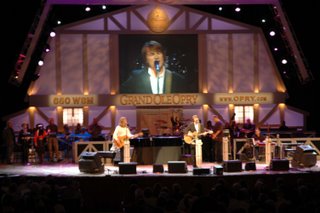
If you don’t know anything about country music – and I don’t – the Grand Ole Opry is something of a mystery. But even if you don’t cotton to the nasal sounds of older-style country music, the pace is so quick that you’ll likely find something you do like.
The show takes place on Tuesdays, Fridays and Saturdays. In summer the show is in the Nashville ‘burbs at the 4,400-seat Grand Ole Opry; in winter it’s in downtown Nashville at the historic Ryman Theater, which holds less than half.
The Opry is a live radio broadcast that lasts two hours. It’s broken up into four half-hour segments, each sponsored by a Southern company that you might not know, such as Martha White Flour or Vietti Foods. (The only one I’d heard of this night was Cracker Barrell.) Each half-hour segment has a host who performs, plus several other acts. The result: If you don’t like one, someone else will be along toot sweet.
I had backstage access, thanks to my friend Tom Adkinson. We passed by the performer’s dressing rooms --- everybody wants No. 1, which was Roy Acuff’s room – and then behind the scenes. I didn’t know most of the performers, but I got to meet Little Jimmy Dickens, who at 85 is quite the charmer and the entertainer. (“You know you’re getting old,’’ he told the crowd,'' when your wife says ‘Let’s go upstairs and make love,’ and you answer, ‘I can’t do both.’ '')
My pick of the night was a newcomer named Rockie Lynne, a handsome fellow who told a story about being adopted at age 4. Country music is all about everyday people in everyday situations, and here it fit.
I actually preferred the music I’d heard during a songwriters’ show at the Bluebird Café (the usual lovelorn stuff, plus some anti-war and other themes) and down in the clubs on Lower Broadway. My fave lyrics were heard at Roberts Western Wear from a songwriter/singer named Dave Cox: “I can’t recall what I should regret, I have a suspicion last night ain’t over yet.’’
Here I am with Little Jimmy Dickens. Top photo, Rockie Lynne on stage. 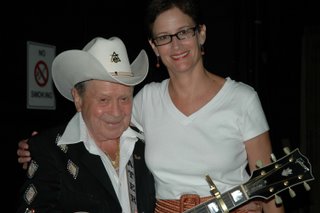
Posted by
DARCOS CRUZ
at
3:56 PM
0
comments
![]()
![]()
Friday, August 25, 2006
Music City

Over the years, Nashville has been about education, commerce, even insurance. But its best known as Music City, and with good reason: Even at 3:30 in the afternoon, you can catch a half-dozen live performances along Lower Broadway.
Come 6 p.m., the first showcase performance by songwriters kicks in over at the Bluebird Café, in a strip mall in the Green Hills area (where Nicole Kidman and husband Kenny Urban are said to frequent the local Starbucks.)
One of the town's biggest hits is Gruhn Guitar -- one of the reader choices for today. Billy Jackson -- a 48-year-old employee who has been coming to Gruhn since he was 13 -- shows us around the new and vintage collection of violins and of course, guitars, including Stratocasters, Martins and Gibsons. The Gretsch guitar that was owned by Dan Fogelberg is priced at $80,000. Newer -- and cheaper -- guitars are also available.
No visit is complete with a stop at the historic Ryman Auditorium, famed for its accoustics, was the original home of the Grand Ole Opry. It was also a church and showhouse, hosting artists including Enrique Caruso, Sarah Bernhardt, Marian Anderson and Roy Rodgers.
And this being a Friday night, the Grand Ole Opry will kick into gear at 8 p.m.
If I weren't hitting the Grand Ole Opry, I'd go to Frist Friday. Every fourth Friday of the month, the Frist Center for visual arts --located in a spectacular WPA-era post office and named for the philantrophic family of U.S. Sen. Bill Frist ... hosts a community concert. Tonight's guest honors the current Egypt exhibition: Pam Tillis will play her hit, The Queen of Denial.
Here are a few scenes from Music City:


---------------
Photos by Jane Wooldridge: Top, on Lower Broadway. Above: Roberts Western Wear doubles as a live music club and beer-and-burger joint; Billy Jackson at Gruhn's Guitars shows off the shop's vintage collection; Lower Broadway signs.
Posted by
DARCOS CRUZ
at
3:21 PM
2
comments
![]()
![]()
Friends and family

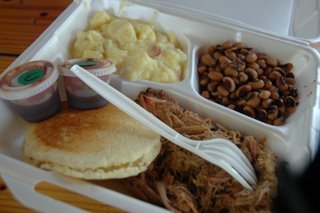
Road trips are partly about visiting friends and family. My family is far from my path, but I have a few friends along the way. Among them are Tom Adkinson, who tells the world about Pigeon Forge, Tenn., and his wife Lois.
I’m staying at their suburban home, a friendly house filled with photos of their family. The kids are now grown, and Tom has graciously taken a few hours to show me around Nashville.
We start at Hog Heaven – tied with Gruhn Guitars as one of the reader voting choices for the day. Hog Heaven is a shack of a place – walk-up window, two picnic tables and some fly screening – known for its barbecue. I go for the pork, which has been my habit on this trip, and end up with the juiciest, tastiest meat I’ve had since I last had N.C. Eastern-style pork barbecue in Raleigh. (Barbecue styles are a raging and constant debate in barbecue circles, but I’m telling you that N.C. Eastern-style is THE BEST.) Hog Heaven’s is pretty fab, though.
Next door is Centennial Park, home to a full-scale replica of the Parthenon (“only ours has a roof,’’ Tom tells me.)
The story goes like this: In the 1800s, Nashville was known as the Athens of the West -- and as the country grew, , the Athens of the South -- for it's prominence in education. (Vanderbilt University is here, in case you’ve forgotten.) At the Centennial Celebration held in Nashville in 1896, the city erected a full-scale replica of the Parthenon. The original wood version was later replaced with masonry.
Posted by
DARCOS CRUZ
at
3:15 PM
1 comments
![]()
![]()
Check out the pix
Hi. We added some fun new photos to yesterday's postings...check them out!
Posted by
DARCOS CRUZ
at
10:40 AM
2
comments
![]()
![]()
Thursday, August 24, 2006
Luggage rebirth

What happens to airline bags that go unclaimed or are permanently separated from their owners? They end up in Scottsboro, Ala.
Like most Southern towns, Scottsboro is a ring of shops – café, antique stores, feed store – surrounding the courthouse. But a couple of blocks away sits a 40,000-square-foot department store filled with the remains of what was once someone’s checked luggage.
For more than 30 years, the Unclaimed Baggage Center has worked with major U.S. airlines, buying the ½ of 1 percent of bags each year that go unmatched with their owners, says spokesman Brenda Cantrell. Some are bags nobody bothered with; some are cargo shipments trapped in red tape. Others are bags that lost their ID tags (a reason, says Cantrell, to put multiple tags both inside and out.)
A visit is more treasure hunt than true shopping excursion. Had they fit, I would have come home with a pair of Ferragamo sandals with cork heels that looked completely unworn for $200 minus a 25 percent discount being offered on some items. Other options included rollaboard suitcases (from $8), long-sleeve T-shirts (from $5), collapsible strollers (from $2), an Ipod ($160), full-length mink coat ($1,000), paperback books (from $2), a Tiffany stainless tank watch ($700) and a kitchen sink – stainless, with two washing bins -- $45.
Not all have been "previously used.'' Those that came from cargo shipment sometimes still have their manufacturer's tags on them.
The ambiance is TJ Maxx-like: a big open space with sections for men’s clothing, women’s clothing, jewelry, etc. “Some people expect a warehouse, other people expect to find suitcases that they rummage through,’’ said Cantrell. “They’re surprised to find it’s so nice.’’
In case you’re heading this way, the Unclaimed Baggage Center is about an hour west of Chattanooga, an hour east of Huntsville – and about an hour southeast of the Jack Daniels distillery in Lynchburg, Tenn. Open Monday-Saturday.
-------------
Photos courtesy of Unclaimed Baggage Center.
Posted by
DARCOS CRUZ
at
7:00 PM
4
comments
![]()
![]()
Must love dogs
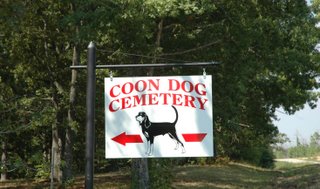
Maybe you’ve got to be a Southerner to appreciate the idea of a Coon Dog Cemetery. Or maybe you just need to know what a Coon Dog is.
A Coon Dog is a hunting hound specially trained to hunt raccoons. In South Florida, of course, you don’t need a hound; just leave your garbage can uncovered or fill your water garden with gold fish, and the raccoons will find you. But we’re talking here about country coon hunting, and that requires a Coon Dog.
Think of fox hunting in England, then take it down a couple of notches in class: jeans, plaid shirts, pick-up trucks and shotguns. That’s coon hunting, a sport dating from Colonial days.
A Coon Dog is truly a man’s best friend; he never rats him out to the wife or girlfriend. He doesn’t whine when the beer is hot or times lean. And when the dog dies, it deserves a place in Coon Dog heaven. Or at least the Coon Dog Cemetery in northwestern Alabama.
To qualify for admission, a dog must be a bona fide coon hunter with a pelt – or at least a treeing – to his credit. And of course, the dog must be dead.
The graveyard was created in 1937 when a local man, Key Underwood, and two friends buried his beloved coon hound Troop. Today, more than 180 loyal canines are immortalized here with wooden signs, crude stones, polished granite headstones engraved with fond words and a flouring garden of plastic flowers.
Reads one: “He wasn’t the best, but he was the best I ever had.’’

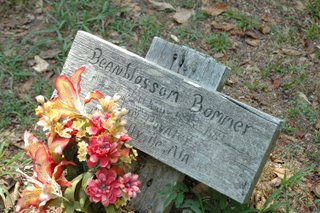
Posted by
DARCOS CRUZ
at
6:56 PM
1 comments
![]()
![]()
Jerusalem in miniature
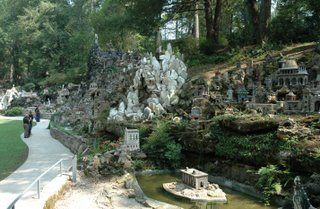
I had the time, and I couldn’t resist stopping at the Ave Maria Grotto, described to me as a miniature Jerusalem at a Benedictine Abbey near Cullman, Alabama, north of Birmingham.
I’d never heard of it until I got an e-mail from one of the monks; it didn't win the vote as one of my stops. And I can guess why: it sounds a bit tacky.
Turns out it’s anything but. The natural garden and surrounding woods have been painstakingly transformed into recreations not only of Jerusalem but of many of the world’s great monuments. Each is a sculpture crafted in stone, shells and colored glass over 40 years by Brother Joseph Zoettl at St. Bernard Abbey.
In its own way, it was much like Birmingham artist Joe Minter’s African Village – a message of hope to the world, and a testament to the things that give meaning to a person’s life.
Brother Joseph believed in Christianity; Joe Minter too believes that society needs a better path.
And what about the rapaciously cruel Bull Connor? He believed his way – of segregation at any cost -- was right. Tunnel vision is a dangerous thing.
Posted by
DARCOS CRUZ
at
6:51 PM
0
comments
![]()
![]()
Helen Keller's courage
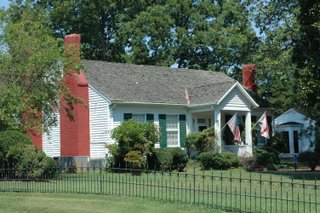
The town of Tuscumbia is pretty, historic little burg. A cold spring flows in the town park, a tribute to the wife of Chief Tuscumbia, for whom the town is named. Fanciful Ionic capitals grace the columns of the county courthouse, and the brick facades are filled with restaurants serving blue-plate specials to grilled chicken on foccacio.
Helen Keller likely never saw any of it. She became blind following an illness at age 19 months. But thanks to her own brilliance, the indulgence and wealth of her parents and the doggedness of her teacher Anne Sullivan, the blind-deaf Keller did more to advance the cause of people with disabilities than anyone in history.
Her birthplace was here, in Tuscumbia, in northwestern Alabama, at her family home of Ivy Green. Today it’s a museum.
A woman named Mary Eubanks – she lived in Miami for a year when she was 12 – showed me around, pointing out the photographic portraits of the Keller family, the furniture (85 percent of it is original), the lacy Victorian garments Helen Keller wore as a young girl, and what’s left of the family china. (Keller smashed much of it in tempestuous rages as a small child, before she learned to communicate in Braille and later, to write.)
By today’s standards, the wooden house isn’t posh, but it was the home of privilege. Keller's ancestors included a Colonial governor of Virginia and President John Quincy Adams, and her father, a Civil War veteran, owned the local newspaper.
“If her family had been poor, they would have put her away,’’ says Eubanks. “It would have been such a shame.’’
Keller’s transformation was memorialized in The Miracle Worker – a play and then movie with Anne Bancroft and Patty Duke. If you’ve never seen, rent it ASAP.
Keller’s father wrote to inventor Alexander Graham Bell for help, who recommended getting a teacher from a school for the deaf. Anne Sullivan was that teacher. When Keller’s parent’s refused to discipline the child, Sullivan took Helen “away’’ – on a two-hour carriage ride that ended in the white cottage next door to the Keller family home. There, the brilliant child learned to spell and then, to put meaning to words. She became the first deaf student at the vaunted Radcliffe College, and then a lecturer and author of 14 books. Keller died in 1968 at the age of 88.
A visit here is study in tenacity and courage: Of Keller’s parents, her teacher, herself. It’s a reminder that it’s not the circumstances life dishes out but how you approach them that shapes who you are.
Posted by
DARCOS CRUZ
at
6:45 PM
5
comments
![]()
![]()
Back on track
Sorry guys, no Internet access last night...I was in the woods at Joe Wheeler State Park in northern Alabama. For reports from the last two days, read on....
Posted by
DARCOS CRUZ
at
6:42 PM
0
comments
![]()
![]()
Wednesday, August 23, 2006
NOTICE: After visiting Helen Keller's birthplace today, Jane is spending her night in an area without internet access. It's been a busy five days, so Jane's taking an early rest! She will post about her visit to the Natchez Trace in the morning.
--------
ALSO: Jane will reach Kansas City on August 30. This is her last predetermined stop until she arrives at Glacier National Park; and almost half of the United States still stands between her and that destination.
It is up to you to direct Jane: WEST or NORTH?
This decision will determine which major landmarks and parks she will hit during the remainder of her trek across America.
She could go west to Colorado, then north to Wyoming (this means skipping Sun Valley, Idaho).
Or she could head north toward South Dakota (possibilities from here include Black Hills, S.D. and Sun Valley).
If you have a specific stop that you want to suggest Jane should visit, make sure and vote for that general route--and then comment here with the details of the location. You might see it on the voting ticket down the line!
Don't forget to participate in the daily vote!
Posted by
Anonymous
at
7:29 PM
10
comments
![]()
![]()
Tuesday, August 22, 2006
Bed rest
The most stressful part of each day is finding a place to stay. It's got to have high-speed Internet access, it's got to be safe.
I've mostly been using the AAA website (I'm a member) to find lodgings, but even with mapping software online and GPS in the car, it's sometimes difficult to determine what kind of neighborhood you're stepping into.
My rule: Find a place before sundown. Today I almost blew it, due to long visits with artists Joe Minter and Chris Clark. When evening approached, I went for safety over budget, and booked into the Pickwick Hotel in the trendy Five Points South neighborhood. At $88, certainly reasonable, but enough to wreck today's budget.
Total miles: 73 miles
Expenses:
- Lunch: $12
- Dinner: $19
- Gas: $18.25
- Hotel: $88 plus tax
- Civil Rights Institute entry: $9
- Joe Minter's book: $28
- Art purchases: We're not telling.
Total: $194
Posted by
DARCOS CRUZ
at
8:57 PM
5
comments
![]()
![]()
In the heart of folk art
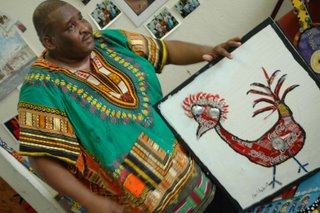
Call them folk, visionary, self-taught or outsider artists. Birmingham is one top place for finding them.
I’ve long been a fan, and with a free afternoon, I tracked down two of Birmingham’s best.
Chris Clark, started quilting in the late 1980s after a bout with diabetes put him in the hospital. It was a craft at which his grandmother and great grandmother excelled. But rather than simply sew together pieces of fabric, Clark painted pictures on them as well.
His grandmother scoffed --but changed her mind when one of his big quilts sold for $1,000.
Like many self-taught artists, Clark uses “found’’ objects – discarded furniture, buttons, soda cans, beads, machine parts – to create paintings, pastiches, hats, sculptures and his signature quilts. Many are reflections of dreams and childhood memories.
He’s a delightful man who loves his art so much that parting with them takes effort. Eventually, most make their way to folk art shows, galleries and private collectors. You can find him at the Kentuck Show the third week of October in Northport, Ala., or online at www.chrisclarkart.com.
Joe Minter sees the world as a continuum heading down a sad path. Like so many men in Birmingham, when the factories closed up Minter was out of work. Nearly two decades ago he asked the Lord for a vision, and that turned him to art.
The result is his African Village surrounding his Birmingham home. At first it may look like a jumble of rambling signs and mismatched metals topped with throwaway toys. But take the tour with Joe, and you’ll soon see that this is conceptual art imbued with sophisticated commentary on slavery, war, the struggle for civil rights and what’s wrong with America. Put it at Art Basel, and it would hold up against works from cutting-edge artists.
Joe doesn’t know Art Basel or installations or conceptual art. He just knows what the Spirit of the Lord has inspired him to do to make the world a better place. “Everything on earth is in harmony except for us, people,’’ he says. “I want to leave a message for the next person.’’
Joe and his wife, Hilda, can be reached at 205-322-7370. Be prepared to spend some time, and to buy his self-published book, To You Through Me, $27.77.

PHOTOS: Top, Chris Clark. Above, Joe Minter at this African Village, home to his tribute to the World Trade Center victims.
Posted by
DARCOS CRUZ
at
8:52 PM
1 comments
![]()
![]()
Great eats
Great restaurant: The Fish Market, a warehouse turned fish market and casual eatery big on ambiance … and incredible food. “It’s better than what we get in Florida,’’ said the man at the Oyster Bar next to me, who has a home in Fort Walton Beach.
My lunch: Trout almandine with crunchy hushpuppies, fried okra and a fresh salad. The tab: Less than $10.
Info: 612 S. 22nd St., Birmingham; 205-322-3330.
Posted by
DARCOS CRUZ
at
8:51 PM
0
comments
![]()
![]()
Civil Rights: Lessons worth remembering

Birmingham was called “the most segregated city in America.’’ The torturous struggle for change is memorialized at the Civil Rights Institute in downtown Birmingham, my assignment for Tuesday.
This is no dry museum. Black life of the time is recreated in music, sets, videos and photos. Here you can read the language of the town’s segregation laws dictating that blacks and whites could not eat in the same room in a restaurant; play cards or checkers or sports together; sit in the same sections in movies, streetcars and buses. Bathrooms, water fountains – everything was segregated.
And this wasn’t a case of “separate but equal.’’ In 1950, the average class size was 35 in white schools, 48 in black schools. The school board spent $120 per white child, half that on a black student. The stereotypes of hapless black man as servant were widely reinforced in advertising and pop culture.
It was a system perpetuated by lynchings attended by laughing white teens and perpetrated by cross-burning Ku Klux Klansmen. For a black man, even looking at a white man the wrong way could lead to death.
When the U.S. Supreme Court banned segregation in schools in 1954, Alabama ignored the ruling. The next decade became a battle between Americans – black and white – who believed segregation to be egregious, and those in Alabama and elsewhere who believed their way was the right way.
The museum recounts in detail the efforts of black and white Freedom Riders, who sought to integrate the interstate bus system in 1961 and were severely beaten for it. Of a local judge who was kidnapped and castrated by the KKK for trying to enforce desegregation. Of sit-ins and boycotts and voter registration drives. And bombings of black-owned homes, businesses and churches – including the 16th Street Baptist Church where four young girls were killed in 1963. One of their murders, Thomas Blanton, was finally convicted of the crime in 2000.
One of the most poignant confrontations was May 4, 1963, when thousands
of Birmingham children rallied in a park kitty-corner from the 16th Street Church – and across the street from today’s Institute. On hand were the Reverends Martin Luther King Jr., Ralph Abernathy and Fred Shuttlesworth. The gathering was peaceful until former mayor and police chief Bull Connor – one of the most vehement defenders of segregation – turned up with attack dogs and water canons. More than 800 youths were arrested that day; the horrifying images shocked the universe, and within days desegregation in Birmingham officially ended.
That day is commemorated in the park by bronzes of water canons, the dogs, and the actual jail bars that were used to incarcerate Dr. King for eight days, during which he wrote his famous “Letter from a Birmingham Jail.’’
If you’re young enough to have bypassed Jim Crow, this is a kind of textbook history, awful though it is. “It’s historical,’’ said visitor Robert Sanders, who grew up in Alabama during segregation and now lives in Boston. “Kids today have no real idea of that this means, and that’s a good thing.’’
It’s personal too for Carlton Harper. He was 11 years old when he attended the rally in the park on that May day. He escaped the dogs and water canons by scrambling over a fence, but his sister was among those arrested.
Harper hangs out in the park many days, explaining what happened here to anyone who cares to listen. A welder by trade, he’s been out of work since the local factories closed up years ago, and now he’s mostly homeless, getting by through day labor and chatting politely, articulately, with tourists. He wants to them to understand what happened. “This is holy ground,’’ he says.
------------
PHOTOS: Top, sculpture of attack dog used by Bull Connor; above, Carlton Harper.
Posted by
DARCOS CRUZ
at
8:41 PM
0
comments
![]()
![]()
Monday, August 21, 2006
Day Two tally
Total miles: 314
Expenses:
Gas: $44.74
Hotel: $50.40
Lunch: $5
Dinner: $13.40
Hall of Fame: $10
Movie: $4
Total: $127.50
Posted by
DARCOS CRUZ
at
9:03 PM
3
comments
![]()
![]()
Thanks for your comments
So many of you have posted comments or sent e-mails. I wish I could respond to each of you individually, but it's just impossible; I'd never get out of my hotel room each day!
I do read the blog comments each day, and we are incorporating them as much as possible in the voting options.
If you've sent me e-mails individually, we'd love it if you'd post your thoughts and comments here on the blog. That enables everyone to see them.
Also, while I'm on the road, I can't access Miami Herald e-mail, even though I can send from it. So it's difficult for me to get your e-mails, and it would help me out if you'd comment here instead.
How to comment: Just click on the word Comments below my latest posting. You can post as "anonymous'' if you don't want to set up a screen name.
Posted by
DARCOS CRUZ
at
8:56 PM
13
comments
![]()
![]()
It takes a team
You see me blogging away, but keeping Miami Herald Travel on to the go takes a team of people. Nearly all of them have complex jobs; Travel is just a tiny piece.
On the print side, Assistant Travel Editor Marjie Lambert keeps things going, with help from Chuck Buhman and Steve Rothaus. Marjie handles all kinds of things while I'm on the road, so be especially nice to her; she's really busy right now!
Karen Burkett produces our Travel on Demand videos, posted every two weeks.
Online, Gina Cardenas takes care of the main Travel page. And the terrific looking voting page where you see my path each day is created by Stephanie Rosenblatt, a UF student who has taken on the role of my keeper during this trip. It's Stephanie who text messages me each evening to tell me where I'm going.
Thanks, everybody!
Posted by
DARCOS CRUZ
at
8:47 PM
0
comments
![]()
![]()
Talladega Days

Driving goes more slowly in the forested hills of a two-lane blacktop than on the Interstate, and the International Motorsports Hall of Fame at the Talladega Superspeedway was just shy of closing when I finally got there. I begged my way in.
I’m no fan of auto racing; I just don’t get what so fascinates my husband and his ilk about cars running around in circles. But the cars themselves I can appreciate, and I especially love the bodacious curves of older models. The Hall of Fame has something for every car aficionado: historic photos, memorabilia, trophies, autos from early ones raced on the beach at Daytona to the carcass of Mike Harmon’s Monte Carlo wrecked at Bristol in 2002. The museum includes special tributes to Davey Allison, an Alabama son and frequent winner at Talladega who died at the speedway in a helicopter crash in 1993.
Since the Hall of Fame first inducted honorees in 1990, drivers in all genres have been heralded, among them Enzo Ferrari, Ettore Bugatti, Richard Petty, Niki Lauda, Emerson Fittipaldi, Al Unser Jr.
Behind the Hall of Fame sits the massive, 140,000-seat Talladega Superspeedway. I missed the last tour of the day, so I did the fitting thing: I went tonight to see the movie, Talladega Nights, right here in Talladega. The Old South town of Talladega 10 miles south of the speedway doesn’t get much play in the movie (which might just has easily have been called Lowe’s Motor Speedway Battle, except it doesn’t have much of a ring to it.) But you get chance enough to see the racetrack, alleviating the guilt I was feeling at missing the tour. It wouldn’t be my top pick of summer movies, but I did find myself laughing a lot. 
Posted by
DARCOS CRUZ
at
8:42 PM
2
comments
![]()
![]()

